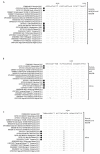Phylogenomic Comparison of Seven African Swine Fever Genotype II Outbreak Viruses (1998-2019) Reveals the Likely African Origin of Georgia 2007/1
- PMID: 37764936
- PMCID: PMC10537866
- DOI: 10.3390/pathogens12091129
Phylogenomic Comparison of Seven African Swine Fever Genotype II Outbreak Viruses (1998-2019) Reveals the Likely African Origin of Georgia 2007/1
Abstract
Since the initial report of African swine fever (ASF) in Kenya in 1921, the disease has predominantly been confined to Africa. However, in 2007, an ASF genotype II virus of unknown provenance was introduced to Georgia. This was followed by its rampant spread to 73 countries, and the disease is now a global threat to pig production, with limited effective treatment and vaccine options. Here, we investigate the origin of Georgia 2007/1 through genome sequencing of three viruses from outbreaks that predated the genotype II introduction to the Caucasus, namely Madagascar (MAD/01/1998), Mozambique (MOZ/01/2005), and Mauritius (MAU/01/2007). In addition, genome sequences were generated for viruses from East African countries historically affected by genotype II (Malawi (MAL/04/2011) and Tanzania (TAN/01/2011)) and newly invaded southern African countries (Zimbabwe (ZIM/2015) and South Africa (RSA/08/2019). Phylogenomic analyses revealed that MOZ/01/2005, MAL/04/2011, ZIM/2015 and RSA/08/2019 share a recent common ancestor with Georgia 2007/1 and that none contain the large (~550 bp) deletion in the MGT110 4L ORF observed in the MAD/01/1998, MAU/01/2007 and TAN/01/2011 isolates. Furthermore, MOZ/01/2005 and Georgia 2007/1 only differ by a single synonymous SNP in the EP402R ORF, confirming that the closest link to Georgia 2007/1 is a virus that was circulating in Mozambique in 2005.
Keywords: African swine fever virus; complete genome sequencing; genotype II; phylogenetics; single nucleotide polymorphisms (SNPs).
Conflict of interest statement
The authors declare no conflict of interest.
Figures






Similar articles
-
Complete genome analysis of African swine fever virus responsible for outbreaks in domestic pigs in 2018 in Burundi and 2019 in Malawi.Trop Anim Health Prod. 2021 Aug 17;53(4):438. doi: 10.1007/s11250-021-02877-y. Trop Anim Health Prod. 2021. PMID: 34402985 Free PMC article.
-
The first complete genome sequence of the African swine fever virus genotype X and serogroup 7 isolated in domestic pigs from the Democratic Republic of Congo.Virol J. 2021 Jan 21;18(1):23. doi: 10.1186/s12985-021-01497-0. Virol J. 2021. PMID: 33478547 Free PMC article.
-
[Analysis of the whole-genome sequence of an ASF virus (Asfarviridae: Asfivirus: African swine fever virus) isolated from a wild boar (Sus scrofa) at the border between Russian Federation and Mongolia].Vopr Virusol. 2022 May 5;67(2):153-164. doi: 10.36233/0507-4088-104. Vopr Virusol. 2022. PMID: 35521988 Russian.
-
[African swine fever in Russian Federation].Vopr Virusol. 2012 Sep-Oct;57(5):4-10. Vopr Virusol. 2012. PMID: 23248852 Review. Russian.
-
African swine fever in the North Caucasus region and the Russian Federation in years 2007-2012.Virus Res. 2013 Apr;173(1):198-203. doi: 10.1016/j.virusres.2012.12.007. Epub 2012 Dec 22. Virus Res. 2013. PMID: 23266725 Review.
Cited by
-
Genome-Wide Approach Identifies Natural Large-Fragment Deletion in ASFV Strains Circulating in Italy During 2023.Pathogens. 2025 Jan 10;14(1):51. doi: 10.3390/pathogens14010051. Pathogens. 2025. PMID: 39861012 Free PMC article.
-
Detection of African Swine Fever Virus Genotype II in West Africa (2020) and Its Co-Circulation With Endemic Genotype I: Implications for Pig Production.Transbound Emerg Dis. 2025 Jun 10;2025:5396227. doi: 10.1155/tbed/5396227. eCollection 2025. Transbound Emerg Dis. 2025. PMID: 40529621 Free PMC article.
-
African Swine Fever Perception, Risk Factors, and Socioeconomic Disparities Among Smallholder Domestic Pig Farmers in Serengeti, Tanzania.Transbound Emerg Dis. 2025 Aug 27;2025:3922067. doi: 10.1155/tbed/3922067. eCollection 2025. Transbound Emerg Dis. 2025. PMID: 40909123 Free PMC article.
-
Analysis of the Unique Historical Isolate of African Swine Fever Virus Isolate Spencer from Outbreaks in 1951.Viruses. 2024 Jul 23;16(8):1175. doi: 10.3390/v16081175. Viruses. 2024. PMID: 39205149 Free PMC article.
References
-
- Sánchez-Vizcaíno J.M., Martínez-López B., Martínez-Avilés M., Martins C., Boinas F., Vialc L., Michaud V., Jori F., Etter E., Albina E., et al. Scientific review on African swine fever. EFSA Support. Publ. 2009;6:5E. doi: 10.2903/sp.efsa.2009.EN-5. - DOI
-
- Penrith M.-L., Thomson G.R., Bastos A.D.S. African swine fever. In: Coetzer J.A.W., Tustin R.C., editors. Infectious Diseases of Livestock. 2nd ed. Volume 2. Oxford University Press; Cape Town, South Africa: 2004. pp. 1323–1365.
Grants and funding
LinkOut - more resources
Full Text Sources
Research Materials

